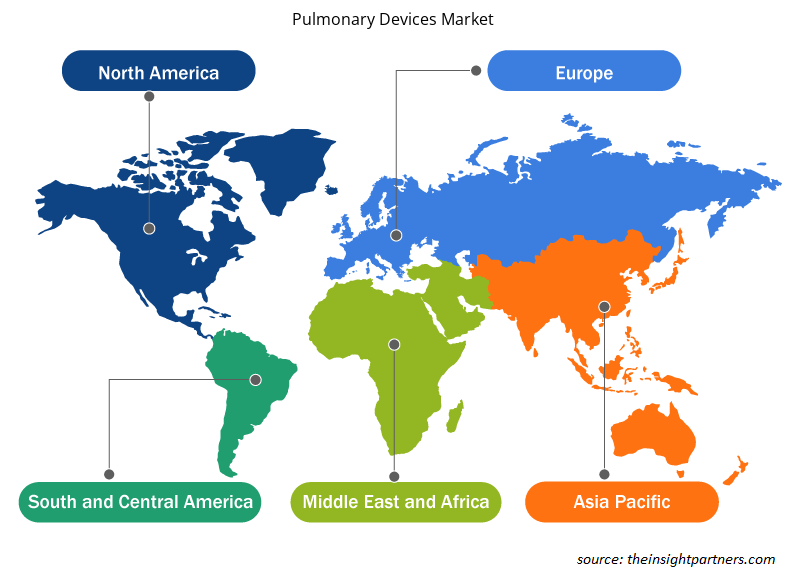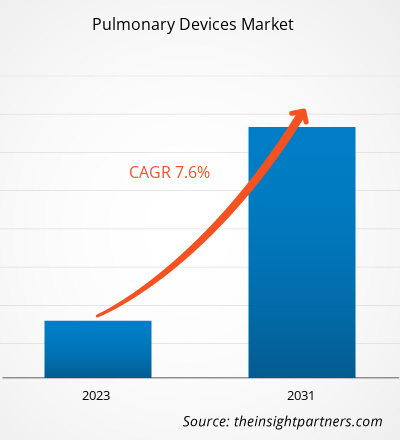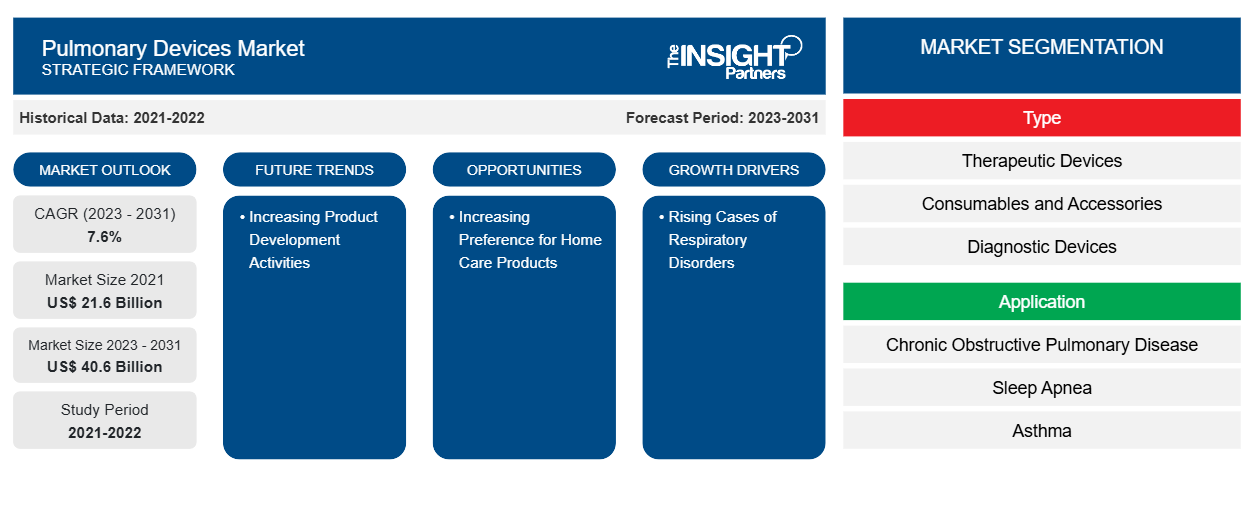Si stima che le dimensioni del mercato dei dispositivi polmonari siano state di 21,6 miliardi di dollari USA nel 2021 e XX miliardi di dollari USA nel 2023 e si prevede che raggiungeranno i 40,6 miliardi di dollari USA entro il 2031; si stima che registrerà un CAGR del 7,6% nel 2023-2031. I crescenti casi di disturbi respiratori e le iniziative strategiche delle aziende sono fattori trainanti. La crescente preferenza per i prodotti per la cura della casa rimarrà probabilmente la chiave per le tendenze del mercato dei dispositivi polmonari.
Analisi di mercato dei dispositivi polmonari
Le malattie polmonari sono tra le condizioni mediche più comuni in tutto il mondo. In tutto il mondo milioni di persone soffrono di vari tipi di malattie respiratorie e i fattori più comuni responsabili sono il fumo, i fattori genetici e le infezioni. Condizioni mediche come l'asma e la broncopneumopatia cronica ostruttiva (BPCO), la bronchite cronica, la fibrosi cistica e il cancro ai polmoni sono tra i maggiori oneri per la salute pubblica. Secondo l'Organizzazione mondiale della sanità (OMS), a livello mondiale la BPCO è la settima causa principale di cattiva salute. Pertanto, i produttori nel mercato dei dispositivi polmonari stanno intensificando la loro attenzione nell'adottare varie strategie, come l'innovazione di prodotto, il lancio di prodotti e le approvazioni, per mantenere un ambiente competitivo nel mercato. Ad esempio, in India, Lupin Limited ha lanciato Vilfuro-G, un farmaco a tripla combinazione a dose fissa per la gestione della broncopneumopatia cronica ostruttiva (BPCO).
Panoramica del mercato dei dispositivi polmonari
L'Asia Pacifica è il mercato in più rapida crescita per i dispositivi polmonari. La crescita è principalmente stimolata dalla maggiore prevalenza di malattie respiratorie e cardiache che richiedono cure ospedaliere e dalle crescenti attività di ricerca. La Cina è tra i paesi più popolati al mondo ed è un paese che ha il numero massimo di pazienti che vivono con disturbi respiratori e cardiaci associati.
Personalizza questo report in base alle tue esigenze
Riceverai la personalizzazione gratuita di qualsiasi report, comprese parti di questo report, o analisi a livello nazionale, pacchetto dati Excel, oltre a usufruire di grandi offerte e sconti per start-up e università
-
Scopri le principali tendenze di mercato in questo rapporto.Questo campione GRATUITO includerà analisi di dati che spaziano dalle tendenze di mercato alle stime e alle previsioni.
Driver e opportunità del mercato dei dispositivi polmonari
Aumento dei casi di disturbi respiratori
La prevalenza di asma, fibrosi cistica, broncopneumopatia cronica ostruttiva (BPCO) e altre malattie respiratorie è in aumento in tutto il mondo. Ad esempio, l'asma contribuisce all'1% di tutti i decessi nella maggior parte dei paesi del mondo. Inoltre, una delle principali cause di malattie respiratorie come la BPCO e l'asma è l'aumento dell'inquinamento atmosferico.COPD), and other respiratory diseases is increasing across the globe. For example, Asthma contributes to 1% of all deaths in most countries worldwide. In addition, one of the major causes of respiratory diseases such as COPD and asthma is the rise in air pollution.
Aumento delle attività di sviluppo prodotto: un’opportunità
Il crescente numero di approvazioni e sviluppi di prodotti rafforzerà la domanda di dispositivi polmonari nei prossimi anni. Ad esempio, la start-up di dispositivi medici Circadia Health ha ricevuto l'approvazione della FDA a giugno 2020 per un dispositivo Circadia C100 basato sull'intelligenza artificiale. Questo dispositivo viene posizionato accanto al letto e consente un monitoraggio continuo, remoto e di livello medico della respirazione. Inoltre, a febbraio 2024, Pulmonx avvia lo studio CONVERT II del sistema AeriSeal nei pazienti con BPCO.Circadia Health received FDA approval in June 2020 for an AI-powered Circadia C100 device. This device is placed at the bedside and allows for continuous, remote, medical-grade monitoring of their breathing. Furthermore, in February 2024, Pulmonx initiates the CONVERT II study of the AeriSeal System in COPD patients.
L'adozione di dispositivi polmonari è aumentata in modo significativo in vari paesi del Nord America, Europa e Asia.
Analisi della segmentazione del rapporto di mercato sui dispositivi polmonari
I segmenti chiave che hanno contribuito alla derivazione dell'analisi di mercato dei dispositivi polmonari sono tipologia, applicazione e utente finale.
- In base al tipo, il mercato dei dispositivi polmonari è segmentato in materiali di consumo e accessori, dispositivi terapeutici, dispositivi diagnostici e dispositivi di monitoraggio. Nel 2023, il segmento dei dispositivi terapeutici deteneva la quota maggiore del mercato. Tuttavia, si prevede che il segmento dei materiali di consumo e degli accessori crescerà al ritmo più rapido durante il periodo di previsione.
- In base all'applicazione, il mercato dei dispositivi polmonari è segmentato in asma, BPCO, apnea notturna , malattie infettive e altri. Il segmento BPCO ha detenuto la quota più alta del mercato dei dispositivi polmonari nel 2023. Inoltre, si prevede che lo stesso segmento assisterà a una crescita a un tasso significativo durante il periodo di previsione.
- In base all'utente finale, il mercato dei dispositivi polmonari è segmentato in ospedali, strutture di assistenza domiciliare e centri di assistenza ambulatoriale. Nel 2023, il segmento ospedaliero deteneva la quota maggiore del mercato. Tuttavia, si prevede che il segmento delle strutture di assistenza domiciliare crescerà al ritmo più rapido durante il periodo di previsione.
Analisi della quota di mercato dei dispositivi polmonari per area geografica
L'ambito geografico del rapporto sul mercato dei dispositivi polmonari è suddiviso principalmente in cinque regioni: Nord America, Asia Pacifico, Europa, Medio Oriente e Africa e Sud America/Sud e Centro America.
Il mercato dei dispositivi polmonari del Nord America è segmentato in Stati Uniti, Canada e Messico. Gli Stati Uniti hanno detenuto la quota maggiore del mercato dei dispositivi polmonari del Nord America nel 2023. La crescita prevista del mercato dei dispositivi polmonari nel Nord America è attribuita a fattori quali la presenza di attori leader del mercato e dei loro sviluppi di prodotto, la crescente popolazione geriatrica e la crescente prevalenza di malattie e infezioni polmonari. Ad esempio, la società ChestPal con sede nel Regno Unito ha lanciato il suo nuovo stetoscopio digitale, ChestPal Pro, per gli operatori sanitari negli Stati Uniti. Questo dispositivo offre il rilevamento e la classificazione automatici di crepitii e sibili, progettato per aiutare i medici a fare diagnosi accurate e rapide, riducendo potenzialmente le visite al pronto soccorso per condizioni respiratorie.
Approfondimenti regionali sul mercato dei dispositivi polmonari
Le tendenze regionali e i fattori che influenzano il mercato dei dispositivi polmonari durante il periodo di previsione sono stati ampiamente spiegati dagli analisti di Insight Partners. Questa sezione discute anche i segmenti e la geografia del mercato dei dispositivi polmonari in Nord America, Europa, Asia Pacifico, Medio Oriente e Africa e America meridionale e centrale.

- Ottieni i dati specifici regionali per il mercato dei dispositivi polmonari
Ambito del rapporto di mercato sui dispositivi polmonari
| Attributo del report | Dettagli |
|---|---|
| Dimensioni del mercato nel 2021 | 21,6 miliardi di dollari USA |
| Dimensioni del mercato entro il 2031 | 40,6 miliardi di dollari USA |
| CAGR globale (2023-2031) | 7,6% |
| Dati storici | 2021-2022 |
| Periodo di previsione | 2023-2031 |
| Segmenti coperti |
Per tipo
|
| Regioni e Paesi coperti |
America del Nord
|
| Leader di mercato e profili aziendali chiave |
|
Densità degli attori del mercato dei dispositivi polmonari: comprendere il suo impatto sulle dinamiche aziendali
Il mercato dei dispositivi polmonari sta crescendo rapidamente, spinto dalla crescente domanda degli utenti finali dovuta a fattori quali l'evoluzione delle preferenze dei consumatori, i progressi tecnologici e una maggiore consapevolezza dei benefici del prodotto. Con l'aumento della domanda, le aziende stanno ampliando le loro offerte, innovando per soddisfare le esigenze dei consumatori e capitalizzando sulle tendenze emergenti, il che alimenta ulteriormente la crescita del mercato.
La densità degli operatori di mercato si riferisce alla distribuzione di aziende o società che operano in un particolare mercato o settore. Indica quanti concorrenti (operatori di mercato) sono presenti in un dato spazio di mercato in relazione alle sue dimensioni o al valore di mercato totale.
Le principali aziende che operano nel mercato dei dispositivi polmonari sono:
- Koninklijke Philips NV
- Caire Inc. (settori grafici)
- Inogen Inc.
- Società Invacare
- Concetti O2
- Tipologie mediche Nidek, Inc.
Disclaimer : le aziende elencate sopra non sono classificate secondo un ordine particolare.

- Ottieni una panoramica dei principali attori del mercato dei dispositivi polmonari
Notizie di mercato e sviluppi recenti sui dispositivi polmonari
Il mercato dei dispositivi polmonari viene valutato raccogliendo dati qualitativi e quantitativi da ricerche primarie e secondarie, che includono importanti pubblicazioni aziendali, dati di associazioni e database. Di seguito è riportato un elenco degli sviluppi nel mercato dei dispositivi polmonari:
- Vitalograph, sviluppatore di dispositivi diagnostici respiratori, ha lanciato la sua serie VitaloPFT Pulmonary Function Testing, destinata all'uso in cure secondarie. Questa nuova serie fornisce soluzioni diagnostiche respiratorie avanzate alle unità di cure primarie e secondarie che richiedono test complessi della funzionalità polmonare. (Fonte: Serum Institute of India (Vitalograph/Comunicato stampa, marzo 2023)
- Xplore Health Technologies ha lanciato un dispositivo di allenamento dei muscoli respiratori (RMT) unico nel suo genere, Airofit Pro. Il prodotto è frutto della collaborazione con Airofit, Danimarca. È il primo sistema di allenamento respiratorio intelligente basato sui dati personali al mondo, al prezzo di Rs 34.990. Il dispositivo può allenare i muscoli inspiratori ed espiratori, un'altra caratteristica unica. (Fonte: Reveal Lasers, comunicato stampa, ottobre 2023)
Copertura e risultati del rapporto sul mercato dei dispositivi polmonari
Il rapporto "Dimensioni e previsioni del mercato dei dispositivi polmonari (2021-2031)" fornisce un'analisi dettagliata del mercato che copre le seguenti aree:
- Dimensioni del mercato e previsioni a livello globale, regionale e nazionale per tutti i segmenti di mercato chiave coperti dall'ambito
- Dinamiche di mercato come fattori trainanti, vincoli e opportunità chiave
- Principali tendenze future
- Analisi dettagliata delle cinque forze PEST/Porter e SWOT
- Analisi di mercato globale e regionale che copre le principali tendenze di mercato, i principali attori, le normative e gli sviluppi recenti del mercato
- Analisi del panorama industriale e della concorrenza che copre la concentrazione del mercato, l'analisi della mappa di calore, i principali attori e gli sviluppi recenti
- Profili aziendali dettagliati
- Analisi storica (2 anni), anno base, previsione (7 anni) con CAGR
- Analisi PEST e SWOT
- Valore/volume delle dimensioni del mercato - Globale, Regionale, Nazionale
- Industria e panorama competitivo
- Set di dati Excel
Report recenti
Testimonianze
Motivo dell'acquisto
- Processo decisionale informato
- Comprensione delle dinamiche di mercato
- Analisi competitiva
- Analisi dei clienti
- Previsioni di mercato
- Mitigazione del rischio
- Pianificazione strategica
- Giustificazione degli investimenti
- Identificazione dei mercati emergenti
- Miglioramento delle strategie di marketing
- Aumento dell'efficienza operativa
- Allineamento alle tendenze normative























 Ottieni un campione gratuito per - Mercato dei dispositivi polmonari
Ottieni un campione gratuito per - Mercato dei dispositivi polmonari